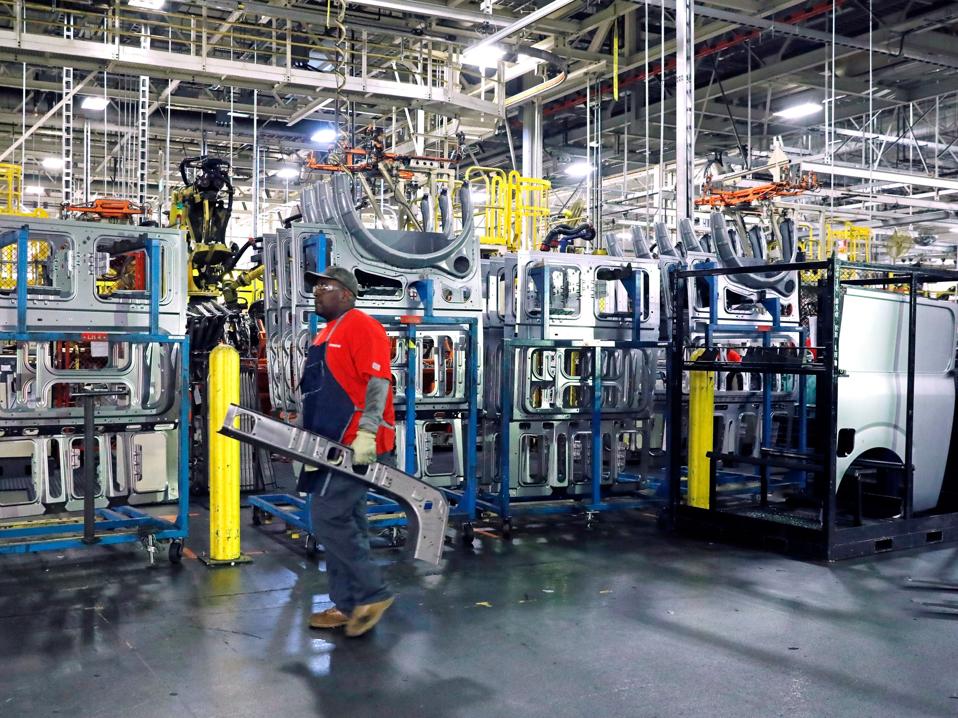Deindustrialization, “the hollowing out of manufacturing in America,” you always hear, began in earnest with President Reagan in the 1980s. In the 1950s and all that decade represented, the United States churned out manufactured products galore. Then everything offshored and we were left with the Rust Belt.
Economist Robert Solow once said that the information technology revolution showed up everywhere except the productivity statistics. Solow was wrong about that. I.T. certainly showed up huge in productivity gains. But if we change the subject of his comment, it works perfectly. Here it is: Deindustrialization has shown up everywhere except in the statistics.
Click this link, from the dowdy Federal Reserve, for the industrial production index of the United States since 1919. This measure motors up fiercely throughout the 1980s, especially in the 1990s, and even in the George W. Bush 2000s. Its permanent flatline—and it certainly is that—came precisely with President Barack Obama. There was no deindustrialization with Reagan, bupkis, for a full generation after 1980.
The growth rates were handsome. From the 1973 peak (the political left always refers to 1973 economic peaks) to that of 1980, industrial production grew by just under 2 percent per year. From the 1980 to the 1989 peak, it rose by 20 percent, a shade higher per annum than the prior average. From then to the 2000 peak was a 50 percent leap, a stupid 3.6 percent per year. And from then until 2007, the W. era mustered a 10 percent gain, 1.5 percent per year.
Tally: industrial production from 1980 to 2000 rose by 80 percent, 3 percent per year. Robert Bartley, the great supply-side editor of the Wall Street Journal, used to say that when confronted with pious leftwing densities about the Reagan achievements, switch to asking a visitor from Mars. What would a completely blank-slate, neutral commentator say about a 3 percent per year growth in industrial production from 1980 to 2000? The being would say that in that era, industrialization proceeded apace.
What a sacred cow it is though. To take away Reagan’s-America-deindustrialized is to tear away from of the left a favorite toy, a security blanket, a stuffed animal gone threadbare from years of cuddling. The mind reels at attempting metaphors. But the fact remains. There was no deindustrialization.
The Rust Belt—what of it? Indisputably, from 1980-2000, Pennsylvania through Illinois and including Michigan all got hollowed out. Vast industrial spaces became moonscapes. All true. Also true is that every one of those states adopted an income tax over 1963-71. New income taxes always fail, and those states then piled on property taxes that now regularly run at 4 percent, as in Pennsylvania’s Fettermanland steel valley which I wrote about here. Manufacturing investors said we will move out of these mistake-prone zones for more intelligent climes in-country. New industrialization happened all over the United States from 1980-2000, as the statistics scream.
One of these places, Tennessee’s location of the Volkswagen plant, will probably face Michigan’s deliciously ghastly fate now that the fatly compensated workers have voted to unionize. The picture books of Detroit’s decline are appalling, a guilty pleasure. Welcome, Chattanooga, to that dumb game.
One may carp that 2-3.6 percent growth is less than post-1945 GDP growth, which was 4-5 percent at its best. We are only talking about one sector here, industry. As an economy matures, it grows new sectors. That is an essential aspect of the genius of economic growth. All the sectors added up in an economy equal 100 percent. Manufacturing cannot grow at the rate of GDP if the economy is maturing well, because legacy sectors have to start sharing the composition of GDP with other neat activities, other neat sectors. This makes in the Reagan-era industrial production numbers all the more impressive. Manufacturing cruised while the economy topped off the performance by adding still more interesting things to make and do that were not manufacturing. It was an accomplishment for the ages. Deindustrialization, my eye.
The same point obtains with respect to manufacturing employment. It fell off in the 1980s and 1990s as productivity soared. This reflects the very purpose of established business. You get better at what you do, freeing you up for doing more without losing anything, only gaining.
Deindustrialization, alas, finally did come. When Rust-Belt-bred, Rust-Belt-proud Obama became president, industrial production pulled up for the duration for the first time ever in American history. Look at that grim graph. We are still at the 2007 peak that W. gifted his successor. Thanks, Obama.

